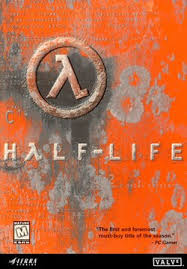Title : Echoes of a Lost Life: Unraveling the Mystery of the Half-Life Seven Hour War
Description: For fans of the iconic Half-Life series, the Seven Hour War is a ghost—a catastrophic, world-altering event that is never seen but whose consequences are felt in every corner of City 17 and beyond. This article provides a deep dive into the most pivotal, off-screen moment in the Half-Life universe. We will explore what we know for certain about humanity’s swift defeat, analyze the most compelling fan theories that fill in the gaps, and offer top-rated recommendations for how you can experience the echoes of this conflict throughout the saga. This is the definitive guide to the war that ended the world and gave birth to a new kind of life under the shadow of the Combine.
Introduction: The World After the Fall
When players first step off the train into City 17 in Half-Life 2, the sense of oppression is immediate and absolute. The sterile, brutalist architecture, the ever-watchful gaze of Civil Protection officers, and the melancholic faces of the citizens all paint a picture of a world that has not just been conquered, but fundamentally broken. This is a world where human life has been devalued to a resource, a society living in the long shadow of a cataclysmic defeat. The central question that hangs over the entire game is: how did it come to this? How did humanity, with all its armies and technologies, fall so completely and so quickly?
The answer is whispered in hushed tones by members of the resistance and referenced with chilling finality by the Combine’s mouthpiece, Dr. Wallace Breen. It is an event known as the Seven Hour War. This conflict, despite its brevity, represents the single most important turning point in the modern history of the Half-Life universe. It is the crucible in which the old world was incinerated and from which the Combine’s despotic new order was forged. This article will dissect this monumental event, exploring the confirmed lore, the tantalizing gaps in our knowledge, and the enduring legacy that defines the entire struggle at the heart of the Half-Life series.
The Precipice of Doom: The World Before the Half-Life Invasion
To understand the Seven Hour War, one must first understand the state of Earth following the Black Mesa Incident depicted in the original Half-Life. The destruction of the Nihilanth at the end of the game did not close the Pandora’s Box that the research facility had opened. Instead, it shattered it completely.
The resonance cascade at Black Mesa had torn a rift between dimensions, and with the Nihilanth’s stabilizing influence gone, this rift devolved into a planet-wide phenomenon known as the Portal Storms. For an indeterminate period between the events of Half-Life and Half-Life 2, Earth was a planet under siege from itself. Rifts to the borderworld, Xen, would open randomly across the globe, disgorging its hostile and confused wildlife into human cities and ecosystems. Headcrabs, Barnacles, and Bullsquids became a terrifying part of daily life.
This period was one of chaos and collapse. Governments struggled to contain the Xenian incursions, economies faltered, and humanity’s focus was turned inward, fighting a decentralized, chaotic war of survival. Society was already frayed, and its military forces were stretched thin, dealing with threats they were biologically and strategically unprepared for. Humanity was weakened, distracted, and vulnerable.
They were a patient on the operating table, bleeding out long before the master surgeon of their destruction—the Combine—even arrived. This pre-war environment was crucial; humanity did not face the Combine at its full strength but as a civilization already in the throes of a slow-motion apocalypse. Their former way of life was already slipping away.
The Seven Hours: What We Know About This Pivotal Half-Life Event
The “Seven Hour War” is a name that is both literal and terrifyingly evocative. It signifies not a prolonged campaign, but a swift, surgical, and overwhelming decapitation of a planet. While Valve has deliberately kept the details sparse to enhance the mythos, several key facts have been established through dialogue and environmental storytelling in the games, particularly Half-Life 2 and the prequel, Half-Life: Alyx.
1. The Arrival of the Combine: Unlike the sporadic portals from Xen, the Combine’s arrival was a global, coordinated event. The interdimensional empire, a vast amalgamation of conquered species and technologies, did not simply stumble upon Earth. They were drawn by the massive energy signature of the Black Mesa resonance cascade. Their invasion was not an exploration; it was a targeted acquisition.
They arrived with a force so technologically superior that it rendered all of humanity’s conventional weapons obsolete in an instant. Imagine fighter jets trying to combat teleporting, energy-wielding synthetic war machines the size of skyscrapers.
2. The Utter Annihilation of Earth’s Defenses: The war was short because it was not a war at all; it was a culling. The Combine’s military might, composed of powerful Synths like the Strider, the Gunship, and the towering Hunter-Choppers, systematically dismantled Earth’s united military forces. The United Nations headquarters in New York was destroyed in a matter of minutes. Military command structures were obliterated before they could even coordinate a response. The conflict was so one-sided that it barely qualified as one. The life humanity had known was being erased hour by hour.
3. The Surrender by Dr. Breen: The key figure in the war’s conclusion was Dr. Wallace Breen, the former administrator of the Black Mesa Research Facility. Seeing the utter futility of resistance and the impending extinction of the human race, Breen used his scientific and political clout to negotiate a conditional surrender with the Combine. In his own propaganda-laced broadcasts in Half-Life 2, he frames this as a moment of salvation.
He argues that by surrendering, he saved humanity from being wiped out entirely. “I have been asked to say a few words to the trans-human arm of Sector 17,” he states in one broadcast, revealing the terrible price of his “salvation.” He delivered the planet to the Combine, and in return, he was appointed as the administrator of Earth—a puppet ruler for an alien regime.
4. The Aftermath: A New Way of Life: The surrender marked the end of the war and the beginning of the Combine’s occupation. The consequences were immediate and horrific.
-
The Suppression Field: The Combine erected a global field that completely inhibited human procreation, ensuring that the current generation would be the last. This was the ultimate act of control, a slow, biological genocide.
-
Systematic Oppression: The remaining humans were herded into designated urban centers, like City 17, where they could be easily monitored and controlled by the Combine’s transhuman military arm, the Overwatch.
-
Resource Depletion: The Combine began stripping the planet of its resources, most notably draining the oceans, as seen in the “Highway 17” chapter of Half-Life 2.
-
Biological Re-engineering: Humans who resisted, or were simply unlucky, were subjected to horrific procedures, turning them into mindless, mutilated servants known as Stalkers, or into the soldiers of the Overwatch themselves—a process that erased their former life and identity.
Filling the Gaps: Fan Theories and the Unspoken Half-Life Lore
The genius of the Seven Hour War’s narrative is in what it doesn’t show. This void has been eagerly filled by the Half-Life community with compelling theories that enrich the lore.
Theory 1: The G-Man’s Role. Where was the enigmatic G-Man during this seven-hour catastrophe? Gordon Freeman was safely in stasis, but the G-Man has always played the long game. A popular theory suggests the G-Man allowed the Combine to conquer Earth. He saw the Portal Storms as a chaotic, dead-end timeline. By permitting the Combine invasion, he created a single, powerful adversary. This created the perfect conditions for him to re-introduce his “asset,” Gordon Freeman, as a “crowbar in the works”—a singular catalyst who could topple an empire from within. In this view, the Seven Hour War wasn’t a tragedy to the G-Man, but a necessary move on a cosmic chessboard.
Theory 2: Breen, the Pragmatist or the Traitor? Was Breen’s surrender a necessary evil to save the human species from extinction, or was it an act of supreme cowardice and opportunism? The games present him as a villain, but the question remains complex. Proponents of the “pragmatist” theory argue that he saw the math—humanity had a 0% chance of victory. Surrender was the only logical option to preserve some semblance of human life. Others argue he was a power-hungry administrator who saw the invasion as his ultimate opportunity to seize control, using the preservation of the species as a convenient excuse to justify his ascension to planetary dictator.
Theory 3: The Aperture Science Factor. A fun, crossover theory posits what might have happened if Aperture Science, from the Portal series, had been involved. Could GLaDOS, with her neurotoxin and advanced portal technology, have been a factor? It’s unlikely she would have helped humanity, but it’s an interesting thought experiment. Could the Combine have detected Aperture’s technology? The events of Portal 2 happen long after the Combine invasion, suggesting the facility remained hidden, a silent, buried testament to a different kind of scientific hubris.
Experiencing the Echoes: Top Rated Half-Life Recommendations to Explore the Lore
The Seven Hour War is not a playable event, but its impact is the bedrock of the modern Half-Life games. To fully appreciate its significance, here are the top-rated recommendations:
-
Half-Life: Alyx (VR): This is the most crucial recommendation for understanding the pre-Gordon era of the occupation. Set five years before Half-Life 2, it provides the most visceral and detailed look at life under the Combine. You see the early days of the resistance, the construction of Combine infrastructure, and the palpable fear of the citizens. It is the closest we have ever come to experiencing the direct aftermath of the war.
-
Half-Life 2 and its Episodes (One & Two): This is the essential experience. The entire narrative is about undoing the damage of the Seven Hour War. You are the direct response to Breen’s surrender. Every battle fought, every ally gained, and every Combine Synth destroyed is a blow against the outcome of that seven-hour period. The dialogue from characters like Eli Vance and Dr. Kleiner constantly references the world before the “dark times.”
-
The “Raising the Bar” Art/Lore Book: For the truly dedicated fan, this official book from Valve offers incredible insight into the development of Half-Life 2. It contains concept art and developer commentary that discusses early ideas for the Combine’s arrival and the state of the world, giving you a behind-the-scenes look at how the lore was constructed.
-
Esteemed Community Mods (PC): The modding community has often tried to tackle this period. While quality varies, mods like the Entropy : Zero series (which lets you play as a Combine officer) offer a fantastic, fan-made perspective on the Combine’s operations and the world they rule. They are a testament to the power of this untold story.
Conclusion: The Enduring Legacy of the Half-Life
The Seven Hour War is more than just a piece of backstory; it is the philosophical core of the Half-Life 2 saga. It represents the ultimate loss of control, the death of a world, and the theft of humanity’s future. The entire journey of Gordon Freeman is a desperate, violent, and hopeful struggle to reclaim that future. The brevity of the war makes the Combine’s power feel absolute and terrifying, which in turn makes the player’s eventual victories all the more meaningful.
By leaving the conflict to our imagination, Valve created something far more powerful than any playable mission could have been. It became a legend, a dark myth that informs every action and decision. The legacy of the Seven Hour War is central to the entire Half-Life saga, serving as a constant reminder of what was lost and a powerful motivator for the fight for a new kind of life. It proves that in the universe of Half-Life, the most impactful battles are sometimes the ones we never get to see.






